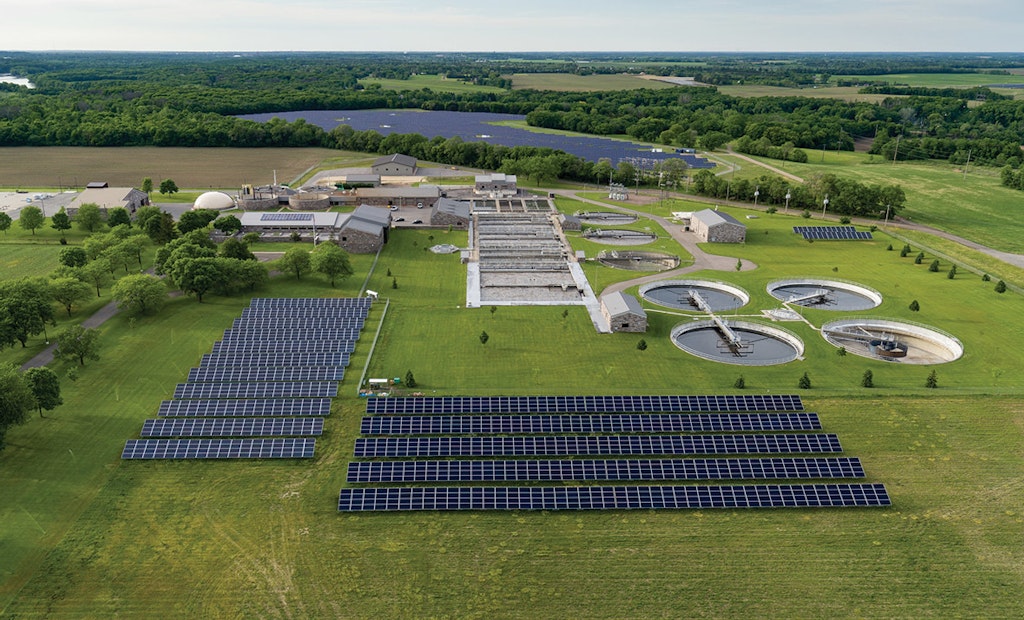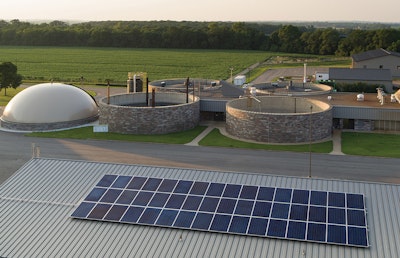
An aerial view of the St. Cloud Energy, Nutrient and Water Recovery Facility shows two of its four arrays of solar panels.
Interested in Energy?
Get Energy articles, news and videos right in your inbox! Sign up now.
Energy + Get AlertsAt the St. Cloud Wastewater Treatment Facility, success led to more success with energy and sustainability projects.
Things moved so quickly that the facility exceeded its 20-year goal for the share of energy produced by on-site renewable resources in just five years. When a second biofuel-burning generator comes online later this year, the plant will almost certainly be producing as much energy as it consumes, or more.
“We’re coming to the point where we need new energy goals,” says Tracy Hodel, public services director for the city of St. Cloud, in central Minnesota. The wastewater plant (17.9 mgd design, 10 mgd average), uses biogas to fuel a generator and heat the digesters. It also generates electricity from four solar arrays — 20 kW, 40 kW, 220 kW and 248 kW.
Toward net-zero
“In 2019 we produced 88% of the power we consumed on site,” Hodel says. “If you include some subscriptions that we have to a community solar garden, we were 99% with our energy coming from renewable resources. We have a second generator coming online, and by 2021 we should be net-zero.”
But energy production is just one of the heavy hitters in St. Cloud’s sustainability lineup.
Energy conservation. After finishing a full biological nutrient removal project in 2013, the plant staff did an energy assessment with energy provider Xcel Energy. That led to savings of 1.6 million kWh per year through a change to LED lighting, upgrades to the HVAC system, and refinements to blower controls and valving.
Nutrient harvesting. In 2018, St. Cloud added the Ostara Nutrient Recovery Technologies process, which removes phosphorus from effluent and produces struvite, a marketable ingredient for fertilizer. The facility produces about 100 tons of struvite a year.
Class A biosolids. St. Cloud switched from Class B liquid biosolids to a Class A product through the Lystek system. The material is dewatered in a centrifuge to 10% to 15% solids cake, which is then treated with mixing, steam and potassium hydroxide. “It liquefies the product, so it acts like a 3% to 4% solid, kind of like ketchup,” says Hodel. “It’s complete resource recovery. Nothing is going to waste.” The addition of potassium makes the product even more appealing to farmers. The city didn’t have to replace or change its field application equipment.
High-strength waste. Waste from food and beverage producers goes directly to the anaerobic digesters. “A large portion of our energy production comes from the high-strength waste,” Hodel says. “They pay us to take it, but it’s a deal for them, too. They would have to pay a lot more to have it hauled away to a different facility, or build their own pretreatment facility to process it.”
Team venture
Hodel credits the plant staff for continually coming up with ideas for sustainability projects and taking inspiration from past successes to transform their workplace into a resource recovery center.
“Our staff identified that we have so much more potential than just wastewater treatment,” Hodel says. “They started thinking about what else we can do here. We’re already making a huge difference by reducing the pollutant load into our receiving waters, but what else can we do? That drive, that passion just triggered these projects not only to start but to succeed.
“Nearly every project we have done to date has been saving the city money and reducing operational and maintenance costs, especially the energy projects. They’ve been successful, so we’re just feeding off each one: This one’s good; let’s try this.”
More to come
Several new projects are in the works. One is a partnership with the University of Minnesota and Beaver Island Brewery. The brewery sends its high-strength waste to the treatment plant, where it is turned into biofuel and Class A biosolids.
The biosolids are applied to a 10-acre field at the treatment facility that is planted with a strain of perennial wheat developed by the university. The wheat has especially long roots that absorb more than the usual amounts of phosphorus and nitrogen. The harvested wheat goes to the brewery as an ingredient.
The success of biogas production has prompted St. Cloud to consider further cleaning the fuel to produce renewable pipeline natural gas for sale to the power company.
Another project on the drawing board is diverting food waste from landfills. The plan is to take food waste from schools, hospitals and other institutions, mechanically separate out the paper and plastic, and put the food into the treatment plant digester to produce more biogas and Class A biosolids.
“We’re working on a pilot,” Hodel says. “I know the school districts and hospitals are looking for a place to put their food waste for their own sustainability goals.”
Appropriately enough, the treatment plant has been renamed the St. Cloud Energy, Nutrient and Water Recovery Facility.






